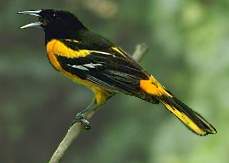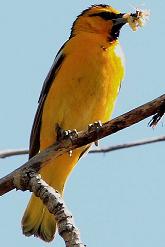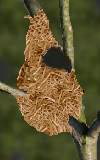 Baltimore Oriole Baltimore Oriole
Baltimore orioles are another favorite of
bird watchers. Some food and water will attract this beauty
to your yard.
Just like the robin, the oriole is a sign of spring, and
summer for many in the United States and Canada. Orioles are
one of the most colorful and vocal of the birds that visit
our backyard feeders, and gardens.
Identification and Pictures -
Baltimore Oriole
 (Classification: Icterus
Galbula) (Classification: Icterus
Galbula)
Baltimore orioles are 7 to 8 inches.
Male orioles are flame orange or yellow with a black hood
that extends to the back. The tail and wings are black with
white wing bars. The female and young are Olive-brown above,
and burnt orange below. Some females will have a black hood
but it is not as pronounced as the male.
 Bullock’s
oriole
is slightly different colors than the Baltimore oriole. Bullock’s has yellow cheeks and a black eye band, and a
large white wing patch. Bullock’s
oriole
is slightly different colors than the Baltimore oriole. Bullock’s has yellow cheeks and a black eye band, and a
large white wing patch.
There is also an Orchard Oriole. The under parts are a
darker orange than the others and the male is much darker.
The white on the wings is not as vivid as it is in the other.
Photo by Keith Lee. The camera I use is
the Canon EOS
40D and a 70 to 300 zoom lens
The Spot breasted oriole looks like
the Baltimore except for an orange head, a black bib, and
spots on the sides of the breast.
There are various hybrid oriels where their ranges overlap.
Song and Sound of the Oriole
The song of the Baltimore oriole is a sequence of rich piping
whistled notes, sometimes with harsh raspy notes. There is
also a tee-dee-dee or hoo-lee sound. Males will tend to have an identifiable pattern. The
female song is less patterned than the male. Loud nasal calls that sound like
dee-dee-dee are made by young birds or
fledglings.
Baltimore Oriole sounds:
1 Click for
Sound
2 Click for Sound
Habitat and Range
Orioles prefer open woods, shade trees orchards, parks, and
gardens with shade trees. They can be found across the
Eastern US and Canada and winter in Florida, the Gulf Coast
and Central and South America.
Nesting and Breeding

In Courtship the male will face the female, and
bow with his wings, and tail spread out. Baltimore
orioles like to breed in thickets
with scattered tall trees near a forest edge or close to
water. The nest built mostly by the female will often be in a
tree or shrub 5 to 15 feet high, however they do put them
much higher. They make a deep pouch or sock like nest that is
bound at the top to branches. It is made of twigs, bark
fibers, string, grasses, and other materials. The nest is
lined with moss, plant down, or fine grasses.
 The female will incubate 3 to 5 eggs.
The eggs
are smooth and glossy. Color is grayish or bluish-white or
with a purple tint. They can be marked with black or
blackish-purple, usually around the large end. The female will incubate 3 to 5 eggs.
The eggs
are smooth and glossy. Color is grayish or bluish-white or
with a purple tint. They can be marked with black or
blackish-purple, usually around the large end.
The young are fed by both parents, and can fly in around two
weeks.
Food and Feeding
Natural foods are caterpillars, other insects, blossoms,
fruit, and berries. They are easily attracted to bird feeders
with fruit, jellies, peanut butter, or suet.
Baltimore orioles will visit birdbaths to bathe, and
drink.
For more on Food
and Feeding click here
More Backyard
Bird Favorites

|
